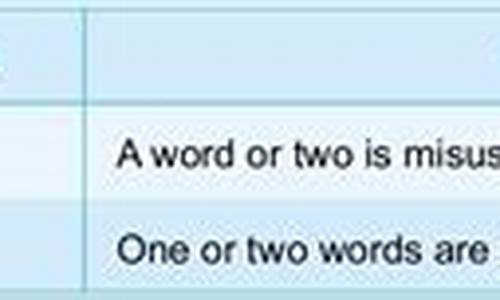句子复数用英语怎么说_句子英语复数怎么读怎么写
1.英文句子变复数: 1.Is he Russian? Yes,he is。 2.Is she Dutch? No she isn·t No I am not。
2.英语单词的复数形式都该怎么变啊?
3.怎样判断英语句子中的单复数
4.老鼠复数
5.介绍的英语怎么读

你是说“主谓一致”吧
比如说:这个苹果是我的。
This le is mine。
而 这些苹果是我的. 就该是:
These les are mine。
你讲的应该是这个地方is 和are 的区别是不是?
is 就是单数的动词了,are就是复数的。
再给你举个例子:
他骑车上学. He goes to school by bike.
他们骑车上学. They go to school by bike.
goes是动词go 的单数形式。
呵呵,写这么多,希望能帮得上。如果真的是,详细的你可以查看“主谓一致”这个语法项.
英文句子变复数: 1.Is he Russian? Yes,he is。 2.Is she Dutch? No she isn·t No I am not。
我们的英语是we,读音是[wi]。
意思:pron.我们。
we是复数第一人称代词的主格形式,其宾格形式是us。在句中用作主语时须用主格形式,用作宾语时用宾格形式,用在动词be后作表语时有时可用主格形式,有时可用宾格形式,如we作为后面句子的真正主语而被强调,则须用主格形式。
辅音
多数辅音的读音与拼音差别不大,可以通过拼音来进行谐音;还有一部分辅音没有对应的拼音字体,这里我们主要是针对/θ/这四个辅音。
其中,/θ/和/?/这两个音标,它们并没有相近似的拼音来对应,主要是靠嘴形来记忆。
/θ/——上下牙齿咬着舌头尖,发“斯"的音;/?/——舌头顶上牙堂发拼音z一声。
/?/——师;/?/——牙齿闭合,舌头虚碰牙齿发拼音r一声。
英语单词的复数形式都该怎么变啊?
1.Is he Russian? Yes,he is。
Are they Russians? Yes, they are.
2.Is she Dutch? No she isn·t No I am not。
Are they Dutch? No, they aren't.
3.Is this your tie? No,it isn·t
Are these your ties? No, they aren't.
4. What colour is your book? It is red and green。 He is Russian。
What colour are your books? They are red and green. They are Russians.
温馨提示:Dutch 单复同形。
怎样判断英语句子中的单复数
首先你需要知道名词的分类,然后分别记忆复数的变化方式
一、名词的分类:
可数名词 个体名词 car, horse, teacher, bike, book, boy
名词 普通名词 集体名词 people, family, class, police, cattle
不可数名词 物质名词 air, rain, snow, water, meat, wood
抽象名词 patience, anger, health, culture
专有名词 Chinese, the Great Wall, (NOTES:专有名词须大写实词首字母)
二、可数名词的复数 (规则&不规则)
1. 规则变化
情况 构成 例词 读音
一般单数名词 词尾+-s desk→desks, map→maps -s在清辅音后发[s]
day → days, girl → girls -s在元音和浊辅音后发[z]
s, x, ch, sh结尾 词尾+-es bus → buses, box → boxes
watch→watches, fish→fishes -es读作[Iz]
辅音字母+y结尾 y→i+-es family→families, factory→factories
party → parties, baby → babies -ies读作[Iz]
f/fe结尾 f/fe→v+-es knife → knives, life → lives
wife → wives, half → halves -ves读作[vz]
辅音字母+o结尾 有生命+-es potato→potatoes, tomato→tomatoes
无生命+s hero→heroes, Negro→Negroes -es读作[z]
2. 不规则变化
a)单复数同形:fish, sheep, deer, Chinese, Japanese, cattle, works, means;
b) dozen (一)打,score二十,head (牛羊的)头(数)。
We order ten dozen (of) buttons.
I want three score eggs.
There are more than two hundred head of cattle on the farm.
c) people, police 常用单数形式表示复数概念。
The police are looking for the missing boy.
d) “某国人”的复数:中日瑞不变英法变,其余-s加后面。
Chinese(Cantonese, Taiwanese), Japanese, Vietnamese, Portuguese, Swiss
Englishman → Englishmen, Frenchman → Frenchmen
German → Germans, American → Americans
三、不可数名词的复数
1. 前无数、冠,后无复数;作主语为三单 (形式为单、谓语动词为单、代词为单)。
2. 表量:
a) 用约数: some/any; much; a lot of等, 如:some milk, much time, a lot of money
b) 用容器: a cup/bottle/glass/box of等, 如:a cup of tea, a box of chocolate
c) 用量词: a piece/drop/slice of等, 如:a drop of blood, a slice of meat
老鼠复数
主要看句子的主语和谓语。
主语如果是复数代词we,you,they,these,those或有复数名词(通常有s词尾),句子就是复数。
主语如果含有both...and...,句子就是复数。
......
谓语部分,如果助动词是are,he,were,*do,或谓语动词是be的are形式,句子就是复数。
......
关于这个问题,最好还是看看语法书上有关主谓语的一致问题。
*****************************************************
主谓语的一致:
1、主语和谓语基本保持单复数的一致,即:主语是可数名词单数或不可数名词时,谓语动词用单数形式:
The computer was a great invention. The water in the glass is very cold.
2、集体名词(如family, class, team, group, row, police, school等)做句子主语时,
① 如果表示整体概念,则谓语用单数形式,如:Class Three is a very good class.
② 如果表示其中的所有成员时,则谓语用复数形式,如:Class Three he a map of China.
3、Chinese,Japanese,fish,sheep,people等表示单个时谓语用单数,表示许多时,谓语用复数。如:
There is a sheep in the yard. / There are some sheep in the yard.
4、maths,news等虽然有s结尾,但不是复数,因此谓语仍用单数:The news is very exciting.
5、glasses,shoes,socks,trousers,gloves等名词往往用复数形式,故谓语用复数。如:
The trousers are very cheap and I want to take them.
6、a lot of 后跟名词复数时谓语用复数形式,跟不可数名词时谓语用单数形式。如:A lot of students are playing baseball now. A lot of time was wasted on that work.
7、and 连接两个名词做主语时,谓语原则上用复数,但是两个名词若构成一个整体事物时,谓语则用单数。如:The teacher and his son are picking les now. Fish and chips is very famous food.
8、 there be 句型中be的单复数一般由靠近的名词决定。如:There is a table and four chairs in the room.
9、用both…and…连接两个事物做主语时,谓语一般用复数。如:Both you and I are required to be here tomorrow.
10、主语中含有with的短语时,谓语单复数由with之前的人物决定。如:A woman with a 7-year-old child was standing at the side of the road.
11、either…or…或者 neither…nor…连接两个人物做句子主语时,谓语用就近原则。如:Either you or he is right. / Neither you nor I am going there.
12、表示一段时间或长度概念的复数名词做主语时,谓语一般用单数。如:Two months is not a short time. Two thousand kilometers is quite a long distance(距离).
13、主语中含有half of… / (three quarters)of… / all (of) the ….等词语时,谓语的单复数由名词确定,如:Over three quarters of the information on the Internet is in English. / A third of the students were playing near the lake. / All of the water in these rivers has been polluted.
但是,population一词又有特殊情况: What’s the population of China? / Three quarters of the population in this city are Arabs(阿拉伯人).
介绍的英语怎么读
老鼠的英文复数是:mice。
拓展:
老鼠mice读音:英音[ma?s] 美音[ma?s] 。
“老鼠”在英文中是“mouse”,而它的复数形式是“mice”。这种复数形式的变化是英语中一种特殊的复数形式,被称为不规则复数。不同于大多数英语名词复数形式在词尾加上“-s”的规则,某些名词的复数形式需要进行不规则变化。
在英语中,有一些名词的复数形式需要记住,因为它们不遵循常规的复数规则。例如,“child”(孩子)的复数是“children”(孩子们),“tooth”(牙齿)的复数是“teeth”(牙齿),“foot”(脚)的复数是“feet”(脚)等等。
“Mice”是“mouse”的复数形式。在句子中,如果我们要描述多个老鼠,就使用“mice”这个单词。以下是一些例句:
There are many mice in the barn.(谷仓里有很多老鼠。)
The cat chased the mice around the house.(猫在房子里追逐老鼠。)
Mice are known for their ability to squeeze through small openings.(老鼠以能够钻过小缝隙而闻名。)
Farmers often use traps to catch mice in their fields.(农民通常使用陷阱在田地里捉老鼠。)
这些例句展示了“mice”这个词在不同句子中的用法。记住不规则复数形式,可以帮助你更准确地使用英语,避免在表达复数时出现错误。
介绍的英语introduction,读法:[?ntr?d?k?n]。
introduction:美音[?ntr?d?k?n],美音[?ntr?d?k?n]。n.介绍;引言,导言;用,引进;新用的东西。复数:introductions。
句子
1、This tutorial is an introduction to ja 3d.
2、Mass introduction of such stoves could deliver multiple green-economy benefits.
3、Polaroid made another breakthrough in 1963 with the introduction of instant color photography.
4、Three Hey Machine,Two Smooth Techniques And A Pump WereCombinedly Introduced,Which Had Oained Good Economic And Social Benefits.
5、Rewrite the introduction to make it stronger.
6、Incidence has gone down since the introduction of central heating.
声明:本站所有文章资源内容,如无特殊说明或标注,均为采集网络资源。如若本站内容侵犯了原著者的合法权益,可联系本站删除。

